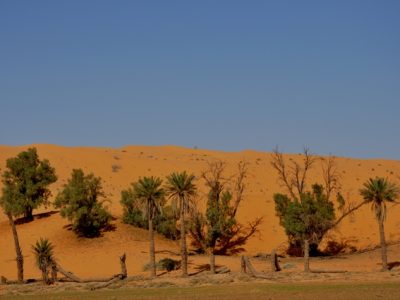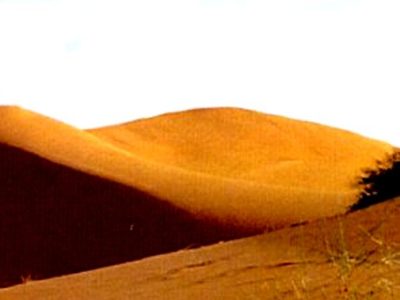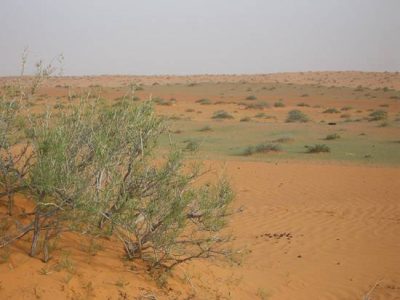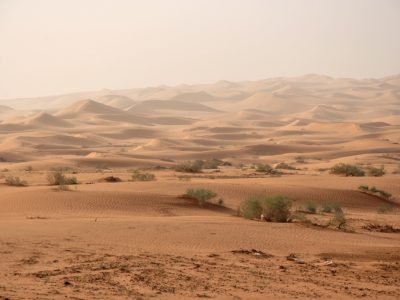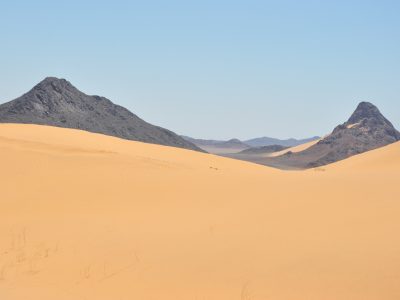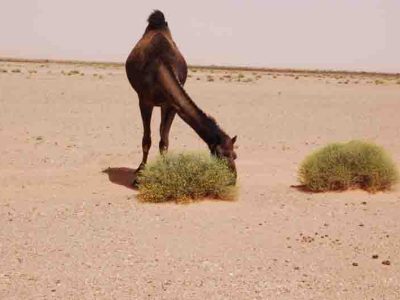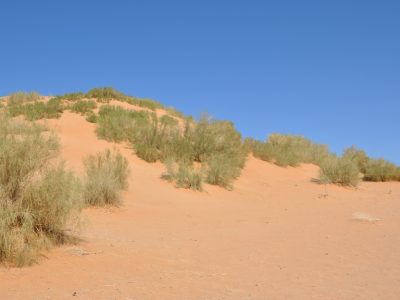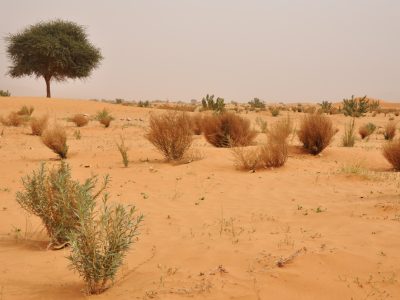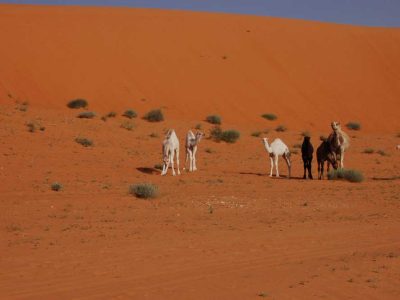Deserts in Saudi Arabia
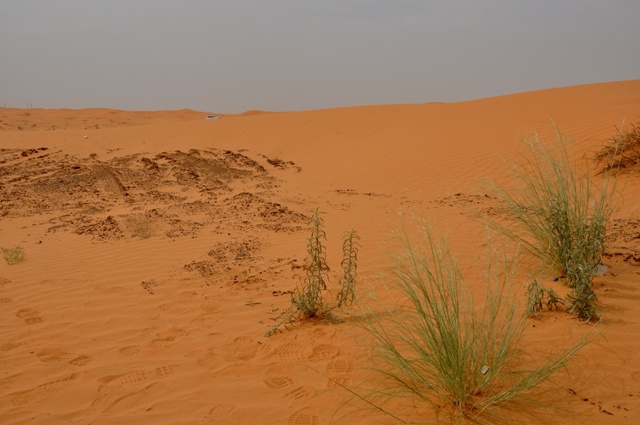
30% of the land in Saudi Arabia is covered by sandy-deserts. Although the desert of Saudi Arabia is more or less continuous, extending from North to South, the Nafud in the north and the Rub-al-Khali in the south are the largest among all. Other sand bodies, such as the crescent-shaped Dahna situated in the Najd Area and the Al-Jafurah on the Eastern region are relatively smaller in size. Rub-al-Khali occupies an area of about 650,000 sq. km with sparse vegetation. Sand dunes in this desert often reach a height of about 250 m, especially on the eastern side of the country. Rainfall is almost nil in this desert. Yet sporadic rains measuring about 35 mm/year are reported in some years. Vegetation composed of diffuse shrubs. Annual plants are virtually nil in this desert. Rub-al-Khali or the ‘Empty Quarter’ is believed to be the largest continuous sand body in the world and supports the life of at least a few endemic plants such as Calligonum crinitum spp. arabicum, Tribulus macropterus var. arabicus (Tribulus arabicus), Cornulaca arabica, etc.
The Great Nafud is composed of transverse sand dunes that often reach up to a height of about 120 m. The sand of Nafud is reddish in colour due to iron oxide coating while the sands of other deserts are somewhat yellowish in colour. The sandy deserts of the central Saudi Arabia consist of an arch-shaped Dahna in the east and a number of smaller sand bodies such as Nafud Al Mazhur, Nafud ath Thuwayrat, Nafud as Sirr, Nadud Qunayfidhah, Nadud ash Shuqayyiqah, Al Urayq, Irq Subay, etc. The sands in these bodies contains high sand ridges with flat interdune beds with shallow, stable sand.
Life in the desert, particularly plants, insects, lizards, rodents, snakes, birds, etc. are highly dependent and each one helps in the survival of the others. As the rains in the deserts are intermittent and erratic, every drop of water that fall on the sand is precious for the existence of plants and animals. Plants have several adaptations that help them to survive in the desert, such as ability to collect and store water, features that help reduce water loss, etc.
Saudi Arabia’s desert ecosystem possesses one of the harshest environments for living beings. However, both animal and plants adapted various forms to adjust their life in that inhospitable habitat. In many situations, such life in the desert is uncompetitive, as many plants particularly tropical and temperate plants do not exist in sandy or rocky deserts due to their inability to adapt hot desert climate. Majority of desert plants do not have broad leaves, rather represented by scaly or needle-like leaves as in the case of Tamarix, Haloxylon, Calligonum, etc. In order to prevent excessive transpiration rate, plants have thick cuticle or waxy coating over stem and leaf surfaces, or have sunken stomata or possess multilevel epidermal layers. Sand covered strong-roots that help to penetrate deep into the soil in search of water and also help the plant to hold firmly on the ground against sand-storms. As far as the animals are concerned, the source of water comes from the plants, while in the case of carnivorous creatures /animals the water need is satisfied by the fluids contained in the bodies of the animals that they live upon.
Many desert species, especially Vachellia spp. have very long tap root system, which often go deep into the soil in search of moisture. The same plant, if grows on wadi produces extensive feeder roots to tap the easily available subterranean water. Their main tap- root may not go deep in search of water. Uprooting of such plants along wadi bed is quite common in Saudi Arabia during flash floods. The above ground parts of many desert plants, particularly short lived perennials or plants having bulbs shed their shoot system during summer months and remain alive at subterranean level and grows again after the first showers during early winter.
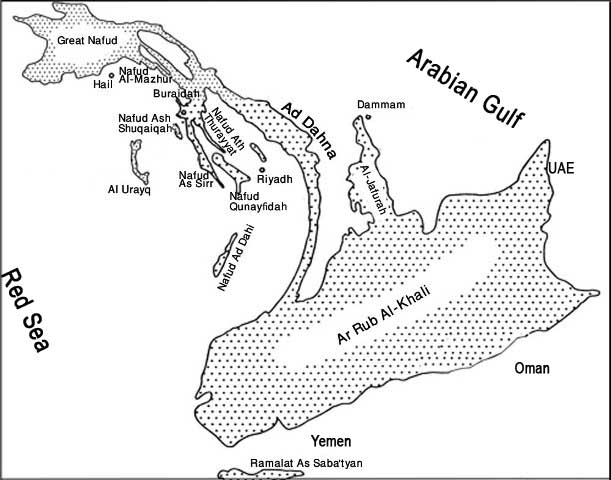
Vegetation of Rub Al-Khali is dominated by three widespread communities, viz. 1. Cornulaca arabica community, 2. Calligonum crinitum- Dipterygium glaucum community and 3. Haloxylon persicum community. Great Nafud and Dahna sands are dominated by Calligonum comosum-Artemisia monosperma-Scrophularia hypercifolia community and Haloxylon persicum-Artemisia monosperma-Stipagrostis drarii community whereas the Jafurah desert is dominated by Calligonum comosum-Cyperus conglomeratus community in the interios and along the borders by Haloxylon salicornicum-Zygophyllum mandavillei or Panicum turgidum communities supported by associated species such as Centropodia fragilis, Dipterygium glaucum, Moltkiopsis ciliata, Stipagrostis drarii, etc. Flora of the major sand bodies in Saudi Arabia is as follows:
| Sand dunes plants of Saudi Arabia* | ||||
| ‘+’ = present ‘-‘ = not present | ||||
| Species | Great Nafud | Dahna | Rub Al-Khali | Jafurah |
| Allium ampleoprasum | + | + | – | – |
| Allium sindjarense | + | – | – | – |
| Ammochloa palaestina | + | – | – | – |
| Andrachne telephioides | + | – | – | – |
| Anthemis deserti | + | + | – | – |
| Arabidopsis erysimoides | + | – | – | – |
| Aretmisia sieberi | + | – | – | – |
| Artemisia monosperma | + | + | – | – |
| Arnebia linearifolia | + | – | – | – |
| Arnebia tinctoria | + | – | – | – |
| Asphodelus refractus | + | – | – | – |
| Astragalus annularis | + | – | – | – |
| Astragalus collinattiae | + | – | – | – |
| Astragalus bombycinus | + | – | – | – |
| Astragalus hauarensis | + | + | – | – |
| Astragalus schimperi | + | + | – | – |
| Astragalus spinosus | + | – | – | – |
| Brassica tournefortii | + | + | – | – |
| Cakile arabica | + | + | – | – |
| Calligonum comosum | + | + | – | – |
| Calligonum crinitum | – | – | + | – |
| Centropodia forskalii | + | + | + | + |
| Centropodia fragilis | + | + | – | – |
| Chrozophora tinctoria | + | + | – | – |
| Cistanche phelypaea | + | – | + | – |
| Cistanche tubulosa | – | + | – | – |
| Colchicum ritchii | + | – | – | – |
| Convolvulus buschiricus | + | – | – | – |
| Cornulaca arabica | – | – | + | – |
| Cornulaca monacantha | – | – | – | + |
| Crucianella membranacea | + | – | – | – |
| Cutandia memphitica | + | + | + | + |
| Cynomorium coccineaum | + | – | – | + |
| Cyperus conglomerates | + | + | + | + |
| Deverra triradaiata ssp. muselii | + | + | – | – |
| Dipcadi erythraeum | + | + | – | – |
| Diplotaxis acris | + | + | – | – |
| Dipterygium glaucum | – | + | + | + |
| Echinops mandavillea | + | – | – | – |
| Ephedra alata | + | – | – | – |
| Ephedra foliata | – | – | + | – |
| Eremobium aegyptiacum | + | + | + | + |
| Erodium laciniatum | + | + | + | + |
| Erucaria hispanica | + | + | – | + |
| Fagonia glutinosa | + | – | – | – |
| Fagonia bruguieri | + | – | – | – |
| Gagea commutata | + | – | – | – |
| Gastrocotyle hispida | + | + | – | – |
| Halothamnus bottae | – | – | + | – |
| Haloxylon persicum | + | + | + | + |
| Haloxylon salicornicum | + | + | – | – |
| Helianthemum aegyptiacum | + | – | – | – |
| Helianthemum ledifolium | + | – | – | – |
| Helianthemum salicifolium | + | – | – | – |
| Heliotropium dygynum | – | + | + | + |
| Hippocrepis bicontorta | + | + | – | – |
| Hyoscyamus pusillus | + | – | – | – |
| Hypecoum geslinii | + | + | – | – |
| Hypecoum pendulum | + | + | – | – |
| Ifloga spicata | + | – | – | – |
| Koelpinia linearis | + | + | – | – |
| Lappula spinocarpos | + | – | – | – |
| Leopoldia tenuiflora | + | – | – | – |
| Lepidium aucheri | + | + | – | – |
| Leptalium filifolium | + | – | – | – |
| Limeum arabicum | + | + | + | – |
| Linaria tenuis | + | + | – | – |
| Loeflingia hispanica | – | + | – | – |
| Lotus halophilus | – | + | – | – |
| Malcolmia pygmaea | + | – | – | – |
| Maresia pygmaea | + | + | – | – |
| Matthiola arabica | + | – | – | – |
| Medicago laciniata | + | + | – | – |
| Moltkiopsis ciliata | + | + | + | + |
| Monsonia nivea | + | + | + | + |
| Neotorularia torulosa | + | – | – | – |
| Neurada procumbens | + | + | + | + |
| Oligomeris linifolia | + | + | – | – |
| Ononis serrata | – | + | – | – |
| Orobanche cernua | + | + | + | + |
| Paronychia desertorum | – | + | – | – |
| Pennisetum divisum | + | – | – | – |
| Phragmites australis | – | – | + | – |
| Plantago boissieri | + | + | + | + |
| Plantago ciliata | + | + | – | – |
| Plantago cylindrica | + | + | – | – |
| Polycarpon succulentum | + | – | – | – |
| Reseda alba ssp. decursiva | + | – | – | – |
| Rhanterium epapposum | + | + | – | – |
| Rostraria cristata | + | – | – | – |
| Rumex pictus | + | + | – | – |
| Savignya parviflora | + | – | – | – |
| Schimpera arabica | + | + | – | – |
| Scrophularia deserti | – | + | – | – |
| Scrophularia hypercifolia | + | + | + | – |
| Scrozonera tortuosissima | – | + | – | – |
| Senecio glaucus | + | – | – | – |
| Silene arabica | + | + | – | – |
| Silene villosa | + | + | + | + |
| Sophora gibbosa | – | + | – | – |
| Stipagrostis drarii | + | + | + | + |
| Stipagrostis plumosa | + | – | + | – |
| Teucrium oliverianum | + | + | – | – |
| Tribulus macropterus var. arabicus | – | – | + | + |
| Tribulus pentandrus | – | + | – | – |
| Trigonella stellata | + | + | – | – |
| Zygophyllum mandaville | – | – | + | – |
Common semi arid plants/Ephemerals reported along the periphery of deep sands.
Acanthaceae
Blepharis ciliaris
Aizoaceae
Aizoon canariense
Mesembryanthemum nodiflorum
Trianthema triquetra
Amaranthaceae
Agathophora alopecuroides
Agriophyllum minus
Amaranthus albus
Anabasis Articulata
Anabasis lachnantha
Atriplex leucoclada
Bassia eriophora
Bassia muricata
Cornulaca leucacantha
Cornulaca monocantha
Halothamnus bottae
Noaea mucronata
Amaryllidaceae
Allium atroviolaceum
Allium sindjarense
Pancratium atroviolaceum
Pancratium sickenbergeri
Pancratium tortousum
Apiaceae
Anisosciadium isosciadium
Anisosciadium woolly
Winding Deverra
Three-radiated Deverra
Pycnocycla tomentosa
Apocynaceae
Cyananchum gerrardii
Leptadenia pyrotechnica
Rhazya stricta
Asparagaceae
Dipcadi erythraeum
Berberidaceae
Leontice leontopetalum
Boraginaceae
Arnebia hispidissima
Arnebia decumbens
Arnebia tinctoria
Echium horridum
Echium rauwolfii
Heliotropium arbainense
Heliotropium bacciferum
Heliotropium digynum
Heliotropium jizanense
Lappula spinocarpos
Paracaryum intermedium
Paracaryum rugulosum
Brassicaceae
Cakile arabica
Brassica tournefortii
Capsella bursa-pastoris
Diplotaxis acris
Diplotaxis erucoides
Spanish erucaria
Farsetia burtonii
Farsetia longisiliqua
Horwoodia dicksoniae
Lepidium aucheri
Matthiola longipetala
Savignya parviflora
Caryophyllaceae
Gypsophila capillaris
Herniaria hirsuta
Paronychia Arabica
Polycarpaea repens
Pteranthus dichotomus
Silenea arabica
Silene villosa
Spergularia diandra
Cleomaceae
Cleome amblyocarpa
Cleome brachycarpa
Cleome pallida
Cleome rupicola
Asteraceae
Aaronsohnia factorovskyi
Anthemis deserti
Artemisia monosperma
Atractylis carduus
Atractylis mernephthae
Calendula arvensis
Centaurea bruguierana
Cotula abyssinica
Filago desertorum
Launaea capitata
Picris babylonica
Reichardia tingitana
Senecio flavus
Zoegea purpurea
Convolvulaceae
Convolvulus excelsus
Convolvulus oxyphyllus ssp. oxycladus
Convolvulus pilosellifolius
Cucurbitaceae
Citrullus colocynthis
Cynomoriaceae
Cynomorium coccineum
Cyperaceae
Cyperus aucheri
Cyperus conglomeratus
Dipsacaceae
Pterocephalus brevis
Ephedraceae
Ephedra alata
Euphorbiaceae
Euphorbia scordifolia
Frankeniaceae
Frankenia pulverulenta
Geraniaceae
Erodium glaucophyllum
Erodium laciniatum
Monsonia nivea
Gisekiaceae
Gisekia pharnaceoides
Hydnoraceae
Hydnora abyssinica
Ixioliriaceae
Ixiolirion tataricum
Lamiaceae
Ajuga arabica
Salvia deserti
Salvia spinosa
Leguminosae
Alhagi graecorum
Astragalus annularis
Astragalus atropilosulus
Astragalus bombycinus
Astragalus caprinus
Astragalus dactylocarpus
Astragalus eremophilus
Astragalus kahiricus
Astragalus tribuloides
Astragalus vogelii
Crotalaria leptocarpa
Hippocrepis areolata
Indigofera argentea
Lotus glioides
Lotus halophilus
Medicago laciniata
Medicago orbicularis
Onobrychis ptolemaica
Ononis natrix
Ononis serrata
Retama raetam
Rhynchosia schimperi
Senna italica
Taverniera aegyptiaca
Trigonella anguina
Trigonella hamosa
Trigonella stellata
Vachellia faba
Vachellia tortilis
Liliaceae
Gagea reticulata
Limeaceae
Limeum arabicum
Molluginaceae
Glinus lotoides
Mollugo cerviana
Neuradaceae
Neurada procumbens
Nyctaginaceae
Boerhavia dffusa
Orobanchaceae
Cistanche phelypaea
Cistanche tubulosa
Orobanche cernua
Papaveraceae
Hypecoum pendulum
Phyllanthaceae
Andrachne aspera
Plantaginaceae
Plantago afra
Plantago boissieri
Plantago ciliata
Plantago coronopus
Plantago cylindrical
Poaceae
Aristida adscensionis
Brachypodium distachyum
Cutandia memphitica
Odyssea mucronata
Sporobolus spicatus
Stipagrostis ciliata
Stipagrostis hirtigluma
Taeniatherum caput-medusae
Tetrapogon cenchriformis
Vulpia myuros
Salvadoraceae
Salvadora persica
Zygophyllaceae
Fagonia bruguieri
Fagonia glutinosa
Tribulus macropterus
Tribulus pentandrus
Tribulus terrestris
Seetzenia lanata
*Please refer the checklist link for correct nomenclature.
